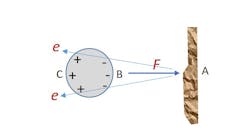Solve This: A Real Dust Up!
Solution to ‘A Real Dust up!’ (see original puzzle below)
We hope you had some fun with this challenge! We don’t usually get so technical in our puzzles but we thought we’d throw this one out to our readers for a little variety.
In general, ‘dust’ particles have no net charge but, like most non-conducting materials, they do have free surface charges. These can line up with an external electric field to form a dipole. If the field is uniform (as, say, from a flat surface) there is no net force on the particle. But an uneven surface creates a divergence of the electric field (stronger at B than C) resulting in the net force (F) pulling the particle towards the surface. Note that the force is always towards the energized surface regardless of the polarity of the electric field. In the illustration below, if the field is reversed then negative charges accumulate at C and positive charges would move to B. But the mechanical force F on the particle would still be towards the surface. It doesn’t matter whether the energizing voltage is DC or AC.
And that’s why uneven energized surfaces, such as the ribbed underside of line insulators, collect a lot of airborne particles and often require periodic washing.
Do you agree with the ‘puzzle’ solution? Disagree? Let us know.
Here's a puzzle for you electricity and physics geeks:
Ever notice that energized equipment collects more dust than the surroundings? Everything from lower voltage electronics to TV screens and high voltage transmission insulators (particularly the convoluted undersides where you'd think they would be protected). AC or DC - it doesn't make much difference.
So...what's going on?

